Cell division, cell diversity and cellular organisation
1/68
There's no tags or description
Looks like no tags are added yet.
Name | Mastery | Learn | Test | Matching | Spaced |
|---|
No study sessions yet.
69 Terms
define cell cycle
a series of events during which the cell duplicates its contents and splits in two.
what are the different part of the cell cycle
label the interphase and mitosis on a circle
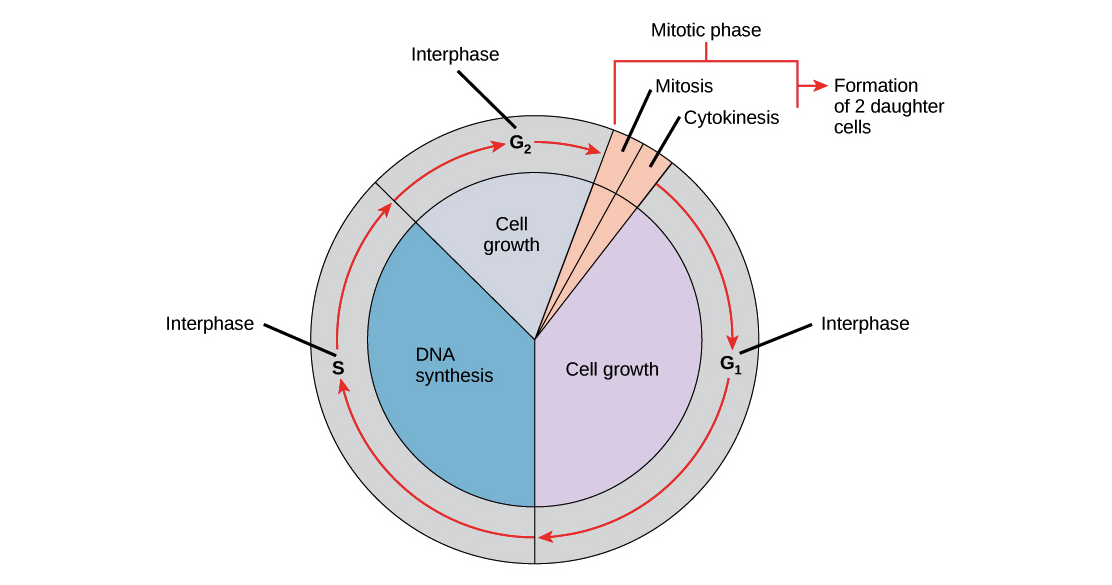
what is interphase used for
is used for copying the chromosomes and checking the genetic information
what generally happens during interphase
increases in size, produces new organelles and stores energy for another division.
what are the stages of the cell cycle during mitosis
G1 phase (growth)
S phase (synthesis)
G2 phase (growth)
Mitosis
what event happens during the G1 phase
the cell grows
transcription of genes
protein synthesis occurs
organelles duplicate
what is checkpoint G1 checking for
ensures that the cell is ready for DNA synthesis
what are the events within the cell during S phase
the DNA replicates- producing pairs of identical sister chromatids
what events occur within the cell during G2 phase
cells grow
what is G2 checkpoint checking for
ensures the cell is ready to undergo mitosis
what events happen within the cell during mitosis
cell growth stops
nuclear division happens in stages of:
prophase
metaphase
anaphase
telophase
cytokinesis
what does the metaphase checkpoint check for
ensures that the cell is ready to complete mitosis
how many genetically identical cells does mitosis produce
2
what is the use of mitosis
1 growth of the organism
2 repair of tissues
3 replacement of old cells
4 asexual reproduction
what happens during the prophase in mitosis
it is the start of mitosis
the chromosomes shorten and thicken as DNA is tightly coiled
each chromosome is visible as 2 chromatids joined at the centromere
prophase ends as the nuclear envelope breaks into smaller pieces
centrioles organise fibrous proteins into the spindle
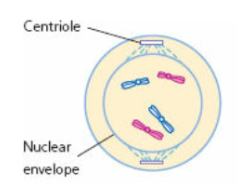
what happens in metaphase during mitosis
chromosomes are held together on the spindle at the middle of the cell
each chromosome is attached to the spindle on either side of its centromere
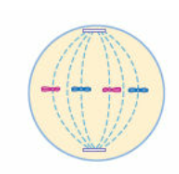
what happens in anaphase during mitosis
chromatids break apart at the centromere and are moved to opposite ends of the cell by the spindle
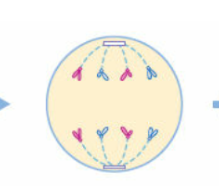
what happens in telophase during mitosis
nuclear envelope reforms around the chromatids that have reached the 2 poles of the cell
each new nucleus has the same number of chromosomes as the original (parent cell)
the nuclei are genetically identical to each other
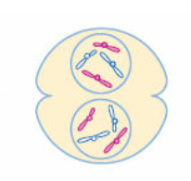

what phase of mitosis does this picture show
prophase

what phase of mitosis does this picture show
telophase

what phase of mitosis does this picture show
metaphase

what phase of mitosis does this picture show
anaphase
how is meiosis different to mitosis
meiosis produces 4 cells
meiosis is not genetically identical
meiosis are gametes
meiosis are haploid cells (contain half the normal number of chromosomes)
what are the cells produced by meiosis and what are they used for
they are gametes which are sex cells used for sexual reproduction
what chromones do gametes contain
These cells contain one chromosome from each pair of homologous chromosomes
what are the properties of the chromones in the gametes in meiosis
the same shape and size
the centromere in the same position
the same genes in the same positions on the chromosomes
what are the stages to meiosis before division starts
Before division starts (during interphase), the DNA replicates so that each chromosome consists of two identical copies called sister chromatids which are held together by a centromere.
The cell divides twice and each division can be divided into four stages.
what are these 4 stages
Prophase 1
Metaphase 1
Anaphase 1
Telophase 1
describe what happens in prophase 1
Chromosomes condense — they supercoil to become shorter and thicker.
Homologous chromosomes pair to form bivalents containing four chromatids.
The chromatids in each bivalent break and rejoin to form chiasmata or crossovers — this is where sections of the non-sister chromatids can be exchanged.
The nuclear membrane breaks up to form small membrane sacs.
The centriole replicates and migrates to opposite poles of the cell and forms the spindle fibres.
describe what happens in Metaphase 1
Microtubules attach from the centrioles to the centromere of each chromosome.
The bivalents move to the equator of the cell.
Orientation of each bivalent on the equator is random — maternal or paternal chromosomes could be facing either pole.
What happens in Anaphase 1
The microtubules shorten to separate the homologous chromosomes and pull them towards opposite poles.
Each chromosome still consists of two chromatids.
What happens in telophase 1
The chromosomes reach opposite poles.
The nuclear membrane reforms around each set of chromosomes to produce two nuclei.
These nuclei are haploid as they have one chromosome from each homologous pair (but there are still two sister chromatids).
The cell membrane pinches in to form two cells — this is cytokinesis.
what happens in prophase 2
The nuclear membranes break up again.
The centrioles replicate again and migrate to opposite poles of the two new cells.
what happens in metaphase 2
Microtubules attach between the centrioles and the centromere of each chromosome.
The chromosomes move to the equator and align randomly.
what happens in Anaphase 2
Sister chromatids move to opposite poles.
What happens in telophase 2
The nuclear membranes reform.
Cytokinesis occurs to produce four genetically different haploid cells.
does mitosis or meiosis create genetic variation
meiosis
how is genetic variation created during meiosis
When chromatids cross over, they exchange lengths of DNA.
If this occurs between non-sister chromatids, it makes new combinations of alleles.
The way the bivalents orientate on the equator during metaphase 1 is random. This means that either the maternal or the paternal chromosome of a bivalent may face either pole.
Therefore, the combination of maternal and paternal chromosomes migrating to either pole is random. This is called independent assortment of homologous chromosomes.
In a similar way, the orientation of the chromosomes on the equator in metaphase 2 is random. Therefore, the combination of chromatids migrating to each pole is random. This is called independent assortment of sister chromatids.
where do the specialised cells come from
multicellular organisms
name the 7 cells that are specialised
Erythocytes (red blood cell)
Neutrophils
sperm
Epitheial cells
Palisade cells
root hair cells
guard cells
how are erythrocytes (red blood cells) specialised
they carry oxygen in the blood. Small and flexible to fit through tiny capillaries, full of haemoglobin to bind to the oxygen, no nucleus to allow more space for haemoglobin. Biconcave shape to provide a large surface area to take up oxygen quickly
how are neutrophils specialised
Neutrophils engulf and digest foreign matter or old cells. Flexible shape to enable movement through tissues. Lobed nucleus to help movement through membranes, many ribosomes to manufacture digestive enzymes. Many lysosomes to hold digestive enzymes, many mitochondria to release the energy needed for activity, well-developed cytoskeleton to enable movement, membrane-bound receptors to recognise materials that needs to be destroyed
how are sperm cells specialised
Sperm carry the paternal chromosomes to the egg, tail (flagellum) to enable rapid movement. Acrosome to help digest egg surface, small to make movement easier, many mitochondria to release the energy needed for rapid movement.
how are epithelial cells specialised
Epithelial cells act as surfaces. Often flat (squamous) to cover a large area, often thin (squamous) to provide a short diffusion distance. May be ciliated to move mucus, may be cuboid to provide a barrier. Many glycolipids and glycoproteins in cell-surface membrane to hold cells together or for cell signalling.
how are palisade cells specialised
Palisade cells for photosynthesis. Elongate to fit many chloroplasts into the space, contain many chloroplasts to absorb as much light as possible. Show cytoplasmic streaming to move the chloroplasts around, contain starch grains to store products of photosynthesis.
how are root hair cell specialised
oot hair cells absorb water and mineral ions from the soil. Long extension (hair) to increase surface area, active pumps in cell-surface membrane to absorb mineral ions by active transport. Thin cell wall to reduce barrier to movement of ions and water.
how are guard cells specialised
Guard cells control the stomatal opening. Active pumps in cell-surface membrane to move mineral ions in and out of cell to alter the water potential. Unevenly thickened wall to cause the cell to change shape as it becomes more turgid. Large vacuole to take up water and expand to open the stoma.
define tissue
A tissue is a collection of cells that work together to perform a particular function. They may be similar to each other or they may perform slightly different roles.
give an example of a tissue and what it contains
• Squamous epithelium is a layer of flattened cells bound together to produce a surface.
• Ciliated epithelium contains ciliated cells that move mucus over their surface and goblet cells that produce the mucus.
what does cartilage consist of
of cells called chondrocytes that secrete a matrix of collagen
what are the 3 types that muscle is found
smooth muscle consists of single cells that can contract
skeletal muscle forms multinucleated fibres containing protein filaments that slide past one another
cardiac muscle forms cross-bridges to ensure that the muscle contracts in a squeezing action.
what is the xylem vessel consisting of
vessels that carry water and xylem fibres for support.
what 2 types of cells is the phloem made of
Sieve tube elements which form sieve tubes
Companion cells.
define organ
An organ is a collection of tissues working together to perform a common function.
define organ system
An organ system is made up of two or more organs working together to perform a life function such as excretion or transport.
define stem cells
Stem cells are a renewing source of undifferentiated cells for the growth and repair of tissues and organs.
define the feature of a stem cells
Stem cells are cells that are not specialised or differentiated. They maintain the capacity to undergo mitosis and differentiate into a range of cell types
define the feature of differentiation
Differentiation is the ability of a cell to specialise to form a particular type of cell.
what happens to stem cells during growth and repair
During growth and repair, stem cells divide to produce new cells, which then differentiate to become specialised to their function.
stem cells have the ability to use…
all their genes
how does differentiation occur
by switching on or off appropriate genes.
how are red blood cells produced by stem cells
Stem cells in the bone marrow divide and differentiate to form both red and white blood cells.
Erythrocytes are specialised to carry oxygen. Their haemoglobin molecules are synthesised during development before the other organelles are lost.
Neutrophils are the most common type of phagocyte used to ingest and destroy bacteria.
how does the production of xylem vessels and phloem sieve tubes link to mitosis
Xylem and phloem are transport tissues in plants. New cells are produced by mitosis in the meristem. These cells are expanded by the uptake of water and the development of a vacuole. They then differentiate into xylem and phloem.
the production of xylem vessels from meristems
Lignin is deposited in their cell walls to strengthen and waterproof the wall. The cells die and the contents are removed as the end walls break down, forming continuous columns of cells. These form tubes with wide lumens to carry water and dissolved minerals. The lignification is incomplete in some places, forming bordered pits.
the production of phloem sieve tubes from meristems
Phloem consists of two types of cell that work together:
1 Sieve tube elements lose their nucleus and most of their organelles. The end walls develop numerous sieve pores to form sieve plates between the elements.
2 Companion cells retain their organelles and can carry out metabolism to obtain and use ATP to actively load sugars into the sieve tubes.
Sieve tube elements and companion cells are linked by numerous plasmodesmata.
what are the potential uses of stem cells in research and medicine
where can stem cells can be sourced from different tissues:
1 embryonic stem cells, which are present in a young embryo
2 blood from the umbilical cord
3 adult stem cells found in developed tissues such as bone marrow (but scientists are finding stem cells in almost all tissues)
4 scientists can also induce certain tissue cells to become stem cells (known as induced pluripotent stem cells or iPS cells).
Stem cells have been used to treat certain conditions and continued research suggests that many uses can be found how have they been used in research and to treat certain conditions
1 Stem cells in bone marrow are used to treat diseases of the blood, such as leukaemia.
2 Stem cells have been used to repair the spinal cord of rats.
3 Stem cells have been used to treat mice with type 1 diabetes.
4 Stem cells in the retina can be made to produce new light-sensitive cells.
5 Stem cells directed to become nerve tissue could be used to treat neurological conditions such as Alzheimer’s disease and Parkinson’s disease.
6 Stem cells may also be used to treat other conditions such as arthritis, stroke, burns, blindness, deafness and heart disease.
how do scientists use stem cells to gain a better understanding of how multicellular organisms develop, grow and mature.
1 They study how differentiation occurs — how cells develop to make particular cell types.
2 They study what happens when differentiation goes wrong.
3 They are trying to find out if they can re-enable differentiation and growth in adult cells to help tissue repair (healing) in later life or even the ability to regrow an organ or limb.